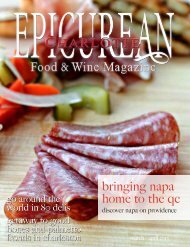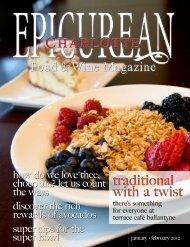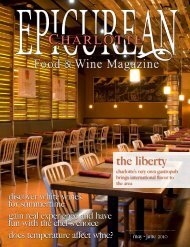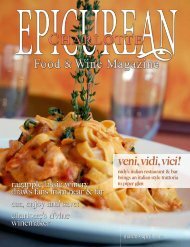señor tequila cantina - Epicurean Charlotte Food & Wine Magazine
señor tequila cantina - Epicurean Charlotte Food & Wine Magazine
señor tequila cantina - Epicurean Charlotte Food & Wine Magazine
You also want an ePaper? Increase the reach of your titles
YUMPU automatically turns print PDFs into web optimized ePapers that Google loves.
Many of the vineyards have the Andes as a backdrop,<br />
making them stand out against the snowcapped<br />
mountains. Chile is a somewhat unique looking country<br />
that stretches down the west coast of South America. It<br />
is, in fact, 2,700 miles long—the longest country in the<br />
world—but only averages 109 miles in width.<br />
The climate in the wine region of Chile is very similar<br />
to California, with average summer temperatures<br />
ranging from 60˚F to 85˚F. Chile really has the perfect<br />
climate for wine growing, with sheltered peaks on one<br />
side and the ocean cooling the land on the other.<br />
In Argentina, the vineyards are located in the western<br />
part of the country among the foothills of the Andes.<br />
Because of the high altitude, Argentina does not have<br />
problems with many of the fungi and insects that affect<br />
vineyards in other countries. This certainly aids with<br />
cultivation of wines, especially the production of organic<br />
varieties. Both countries also have the benefit of the<br />
melting snow from the Andes Mountains, which provides<br />
irrigation to the vineyards.<br />
Spain is not the only country to have influenced<br />
both Chile and Argentina in the development of wine,<br />
however. France and Italy have definitely had their say.<br />
France introduced Malbec to Argentina and their<br />
Bordeaux proved a strong favorite in Chile, while the<br />
Italians brought Bonarda to Argentina.<br />
It is often difficult to select a wine when you may not<br />
be familiar with the country of origin, so I am going to recommend<br />
a couple of my favorites. All the wines that I am<br />
going to suggest typically cost less than $12.00 per bottle.<br />
Personally, I enjoy a nice vibrant Merlot, so my first<br />
choice is Travesia Merlot from Chile, a wine that is easy<br />
to drink with or without food. This is a super smooth red<br />
wine, lush with the fruits of cherry and plum that come<br />
to the forefront, giving it a velvety taste.<br />
Another Chilean wine that offers good value, this<br />
time a white, is Travesia Sauvignon Blanc, a fresh and<br />
crisp choice. Light and refreshing with a combination of<br />
grapefruit and mouth-watering lemon, this wine from the<br />
Central Valley of Chile sells for under $10.00 a bottle, a<br />
tremendous value.<br />
My personal favorite comes from the Casablanca<br />
Valley—Veramonte Merlot—and costs around $12.00 per<br />
bottle. It is without a doubt one of Chile’s true Merlots.<br />
The Veramonte has a wonderful aroma of rich blackberries<br />
and cherry spiced with black pepper, along with<br />
hints of eucalyptus and mint, with a subtle underlay of<br />
oak. It has a youthful flavor of dark fruit and is rich and<br />
full of generous berry flavors.<br />
Two wines that I recommend from Argentina—Tilia<br />
Cabernet Sauvignon and Tilia Malbec. The Cabernet<br />
is the king of the red grape—a small berry with a thick<br />
skin that creates a wine high in color. It is earthy with the<br />
taste of black currant cassis, herbs, cedar, and tobacco.<br />
Malbec is the national grape of Argentina; it creates<br />
spicy wines reminiscent of blackberries and chocolate<br />
with a velvety texture. It is dark, full bodied and inky.<br />
Lastly, my personal favorite is the Don Paula<br />
Malbec 2009, which has all the ingredients that make<br />
the Malbec grape so special. You may find that this wine<br />
costs a couple of dollars more, but believe me, it’s well<br />
worth it.E<br />
Eddie Mitchell, who is London (UK) born, has lived in the U.S. for 28 years, North Carolina for<br />
18. While playing professional soccer, he visited over 60 countries.<br />
1 www.epicureancharlotte.com volume • issue 2<br />
©iStoCkphoto.Com/JoSé CarloS pireS pereira; oppoSite: ©iStoCkphoto.Com/kedSanee; ©iStoCkphoto.Com/ina peterS<br />
I'm not a morning person; you will never<br />
find me voluntarily awake before 7 a.m. Nor<br />
am I a night owl; I finally got past my youthcrazed<br />
drive to stay up until all-hours, and<br />
nowadays, the nights I'm awake past midnight<br />
are few and far between. I, for one, peak and<br />
thrive right about mid-day; it's during those<br />
hours that I'm at my absolute best. In fact,<br />
we all have our<br />
unique biorhy thms<br />
and body clocks, with<br />
low points and high<br />
points and plateaus<br />
in-between. And you<br />
know what? So does<br />
wine—and even during<br />
just one evening.<br />
Think of it this<br />
way: bottled wine is<br />
dormant wine. While<br />
plugged up in a glass<br />
bottle for months<br />
(if not years), wine<br />
is, well, asleep. And<br />
just as we do while<br />
we sleep, a wine<br />
slowly changes; it<br />
develops, grows and<br />
transforms during<br />
the period of time<br />
before the bottle in<br />
which it's contained<br />
is opened. Similar<br />
to when we awake<br />
from our own sleep,<br />
a wine starts off a<br />
bit sullen and groggy,<br />
and after being uncorked, really begins<br />
to show itself, to awaken to its full glory and<br />
express and interact to its fullest potential.<br />
So where am I going with this? Simple: you'll<br />
notice that only until after a solid few hours<br />
of having opened a bottle of wine, that it's at<br />
its absolute best. And the reason is oxygen:<br />
the very thing that will ultimately degrade a<br />
wine and turn in into vinegar (in a biochemical<br />
lying dormant<br />
by nikitas magel<br />
reaction whose explanation is beyond the<br />
scope of this article) will, in the short term, be<br />
the same thing that seduces it into its most<br />
expressive state.<br />
The most ready example of this can be found<br />
in a bottle that's opened on one evening—then<br />
set aside unfinished, re-corked and consumed<br />
the following evening—is almost invariably better<br />
the following night.<br />
And that's simply<br />
because the wine has<br />
been exposed to just<br />
enough air to react<br />
with the complex<br />
aroma and f lavor<br />
compounds to bring it<br />
to its best.<br />
Any time I have<br />
the chance to plan a<br />
bit in advance, I open<br />
a bottle of wine in<br />
the morning before<br />
I start my day, pour<br />
a bit into a glass (it's<br />
not enough to just<br />
uncork it—you need<br />
to get some air into<br />
that bottle) and then<br />
set it aside until later<br />
that evening. Sure,<br />
the idea of opening<br />
a bottle of wine while<br />
you're hankering for a<br />
early morning caffeine<br />
fix may be unappealing,<br />
but you're not<br />
sipping any thing…<br />
just doing a minute or so of preparation.<br />
So get over it! Whip out the bottle, open<br />
it, pour a bit in a glass and push it aside until<br />
dinner time. It truly does make a difference.<br />
What's more is you'll notice—assuming you've<br />
had no company to help you finish it off that<br />
same evening—that the leftover wine is even<br />
better the following evening, after having been<br />
aerating for a day and a half.<br />
epicurean charlotte food & wine march • april 2011<br />
1












